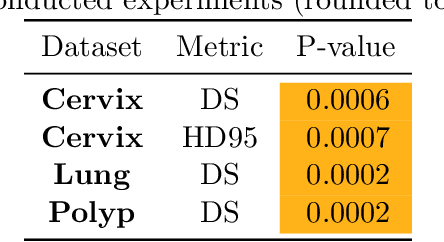Alexander Chebykin
Hyperparameter-Free Medical Image Synthesis for Sharing Data and Improving Site-Specific Segmentation
Apr 09, 2024



Abstract:Sharing synthetic medical images is a promising alternative to sharing real images that can improve patient privacy and data security. To get good results, existing methods for medical image synthesis must be manually adjusted when they are applied to unseen data. To remove this manual burden, we introduce a Hyperparameter-Free distributed learning method for automatic medical image Synthesis, Sharing, and Segmentation called HyFree-S3. For three diverse segmentation settings (pelvic MRIs, lung X-rays, polyp photos), the use of HyFree-S3 results in improved performance over training only with site-specific data (in the majority of cases). The hyperparameter-free nature of the method should make data synthesis and sharing easier, potentially leading to an increase in the quantity of available data and consequently the quality of the models trained that may ultimately be applied in the clinic. Our code is available at https://github.com/AwesomeLemon/HyFree-S3
Shrink-Perturb Improves Architecture Mixing during Population Based Training for Neural Architecture Search
Jul 28, 2023Abstract:In this work, we show that simultaneously training and mixing neural networks is a promising way to conduct Neural Architecture Search (NAS). For hyperparameter optimization, reusing the partially trained weights allows for efficient search, as was previously demonstrated by the Population Based Training (PBT) algorithm. We propose PBT-NAS, an adaptation of PBT to NAS where architectures are improved during training by replacing poorly-performing networks in a population with the result of mixing well-performing ones and inheriting the weights using the shrink-perturb technique. After PBT-NAS terminates, the created networks can be directly used without retraining. PBT-NAS is highly parallelizable and effective: on challenging tasks (image generation and reinforcement learning) PBT-NAS achieves superior performance compared to baselines (random search and mutation-based PBT).
Multi-Objective Population Based Training
Jun 02, 2023Abstract:Population Based Training (PBT) is an efficient hyperparameter optimization algorithm. PBT is a single-objective algorithm, but many real-world hyperparameter optimization problems involve two or more conflicting objectives. In this work, we therefore introduce a multi-objective version of PBT, MO-PBT. Our experiments on diverse multi-objective hyperparameter optimization problems (Precision/Recall, Accuracy/Fairness, Accuracy/Adversarial Robustness) show that MO-PBT outperforms random search, single-objective PBT, and the state-of-the-art multi-objective hyperparameter optimization algorithm MO-ASHA.
Evolutionary Neural Cascade Search across Supernetworks
Mar 08, 2022



Abstract:To achieve excellent performance with modern neural networks, having the right network architecture is important. Neural Architecture Search (NAS) concerns the automatic discovery of task-specific network architectures. Modern NAS approaches leverage supernetworks whose subnetworks encode candidate neural network architectures. These subnetworks can be trained simultaneously, removing the need to train each network from scratch, thereby increasing the efficiency of NAS. A recent method called Neural Architecture Transfer (NAT) further improves the efficiency of NAS for computer vision tasks by using a multi-objective evolutionary algorithm to find high-quality subnetworks of a supernetwork pretrained on ImageNet. Building upon NAT, we introduce ENCAS - Evolutionary Neural Cascade Search. ENCAS can be used to search over multiple pretrained supernetworks to achieve a trade-off front of cascades of different neural network architectures, maximizing accuracy while minimizing FLOPS count. We test ENCAS on common computer vision benchmarks (CIFAR-10, CIFAR-100, ImageNet) and achieve Pareto dominance over previous state-of-the-art NAS models up to 1.5 GFLOPS. Additionally, applying ENCAS to a pool of 518 publicly available ImageNet classifiers leads to Pareto dominance in all computation regimes and to increasing the maximum accuracy from 88.6% to 89.0%, accompanied by an 18\% decrease in computation effort from 362 to 296 GFLOPS. Our code is available at https://github.com/AwesomeLemon/ENCAS
 Add to Chrome
Add to Chrome Add to Firefox
Add to Firefox Add to Edge
Add to Edge